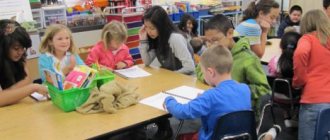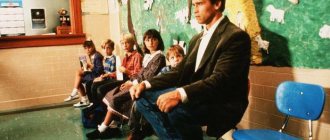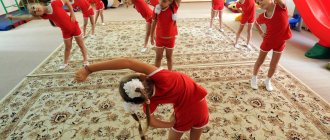Final lessons in kindergarten: structure and analysis
In its structure, the final lesson in kindergarten should, in principle, not differ from a regular lesson. It must necessarily contain things familiar to the teacher: goals, program content, description of the course of the lesson, methods and materials.
If you are a teacher or trainee, then one of your tasks may be an analysis of the final lesson. All teachers must conduct pedagogical analysis as part of mutual visits and exchange of experience.
The analysis of the final lesson should include the following points:
- characteristics of children,
- degree of difficulty of the lesson,
- characteristics of software tasks,
- feedback on the type of activity and its correspondence to the age of the children, as well as the tasks set.
The analysis should also contain information about the degree of disclosure of the methods and techniques used, highlighting the pros and cons of the lesson.
Final classes in kindergarten: general recommendations
In order for the final lesson in a solemn atmosphere to fulfill its direct function, you should not pay much attention to extracurricular activities, for example, reading poems about school (if this is not a reading lesson). Try to imbue every element of the lesson with educational meaning.
Particular attention should be paid to the rules of conduct at school, safety rules, and the peculiarities of the school education system. Of course, all this knowledge must be correctly integrated into the structure of the lesson and adapted to the age of the children. Don’t forget about the mandatory warm-up and other mandatory attributes of any lesson.
Final classes in kindergarten should not fall out too much, stand out from the flow of the educational process, but at the same time, children should feel that now, in this lesson, there is a confirmation of what has already been learned, that this is the last, confirming lesson. At the same time, you should not let children completely plunge into the atmosphere of the holiday without educational elements - they will still have a separate, solemn farewell holiday, but the lesson should still remain a lesson.
Unfortunately, many parents continue to overload their children with additional activities to prepare for school, although any educational program at a preschool educational institution provides the child with the necessary knowledge and skills. Therefore, teachers often notice that at the end of the school year, many children have increased fatigue and problems with the perception of educational material. Don’t forget to conduct educational programs with parents so that preparation for school proceeds correctly.
Since at the end of the year children’s attention is “shaken”, and, even more so, this intensifies in anticipation of going to school, the entire study load towards the end of the year (and the final lesson too) needs to be filled with as many unobtrusive exercises as possible in a playful way.
Final integrated lesson in the senior group with presentation
Final integrated lesson in the senior group
Author: Natalya Vladimirovna Merzlyakova, teacher of the “Solnyshko” kindergarten, p.
Ynyrga, Municipal Educational Institution “Ynyrginskaya Secondary School”, Choysky District, Altai Republic Direct educational activities in the senior group “On the roads of the rainbow”
Description: A summary of the educational activity in the senior group of the kindergarten will be useful for kindergarten teachers during monitoring. Goal: generalization and consolidation of knowledge among children of the senior group based on the material covered during the school year through the organization of various types of activities. Objectives: Educational: - consolidate the characteristic features of the seasons, names of months, days of the week; - practice naming morning, day, evening, night, have an idea of the changing parts of the day; - consolidate the counting of cardinal and ordinal numbers (within 10, the ability to compare objects by eye (by length, height); determine the accuracy of executions by superimposition or application; - practice classifying objects, determining the material from which they are made; - practice selecting several adjectives; - improve the ability to move in a given direction and define it with words: forward, backward, right, left; - consolidate the ability to use generalizing words. Developmental: - expand the vocabulary of children, dialogical speech; - develop logical thinking; - consolidate the ability establish cause-effect relationships; - develop hand motor skills. Educating: - cultivate curiosity, observation; - cultivate mutual assistance, independence. Form of work - frontal, individual, in pairs. Type of lesson - consolidation. Stages of the lesson: 1. Organizational moment. Surprise moment 2. Motivation - setting goals and objectives for children. 3. The main one is direct work with children. 4. Reinforcing – conclusions, rewarding. Methods used: Game method, visual, verbal, encouragement. As well as the cognitive method (tasks, ingenuity), social (forms of work), emotional (atmosphere during work, interest in tasks), reflection (results, conclusions, conversations on issues), control during work (oral, frontal, check each other, encouragement). Progress of the GCD The teacher, dressed as an artist, meets the children. The music “Yeralash - Music of Happiness” is playing. Educator: Guys, have you guessed who I am? Children: Artist. Educator: Guys, guests came to us today. Let's say hello to them and stand in a circle. (Children say hello and stand in a circle).
I see a wide circle. All my friends have stood up.
We'll go right now, and now we'll go left. Let's gather in the center of the circle And we'll all return to our place We'll all smile at each other. Educator: Hello guys, that’s right, I’m an artist and I’ve prepared a beautiful picture for you, which I painted myself, but first guess the riddle: With a multi-colored rocker hanging in the blue sky, A seven-colored arc, Undoubtedly...a rainbow Here it is, look! (There is 1 image of a rainbow on the slide).
What a miracle - miracles, the rainbow came to visit and brought paths, All the paths are not simple, but so magical!
Whoever walks along the path plays, knows a lot, always speaks beautifully, and is in a hurry to go to school! Educator: Guys, do you want to go to the preparatory group? (yes) (The rainbow goes out.) Educator: Oh, something happened, the rainbow disappeared! How are we going to go to school now? I'll probably have to stay in the older group, since I won't be able to draw the same rainbow anymore, I don't remember the order of the colors. Or can you help me remember the arrangement of the colors of the rainbow? (Yes). Educator: Okay. The teacher put her hands in her pockets and suddenly takes out 7 colored envelopes. Educator: Oh, guys, look, I have colored envelopes for you. In each there are tasks that must be completed, but in a certain sequence you need to take the envelopes so that the rainbow is restored correctly. A difficult task lies before us. Guys, are you ready to walk the difficult path along the paths of the rainbow, test your knowledge of what we have learned over the year, and go to school. Children: yes! Educator: But before we start completing the tasks, you and I need to remember how many colors the rainbow has? (7). Name these colors. (Red, orange, yellow, green, blue, indigo, violet). Educator: Let's quickly open 1 envelope with the task! Oh, I don’t even know which one to choose, in case I make a mistake again and mix up the colors. Help me, which envelope color should I choose first? Children: Red! (open the red envelope) Educator: Reads the task
It gets light early in the morning, all the snow has melted here and there, The stream is noisy like a waterfall, starlings are flying into birdhouses, Drops are ringing under the roofs, a bear has risen from the spruce tree, The sun is caressing everyone with warmth, who is it? does he know the year?
Children: spring. Slide 2 shows a picture about spring. Educator: Name the months of spring? How many are there? (3). Which? (March April May)
.
After a harsh, long winter, spring has come. Let's describe in words what spring is like? (children take turns naming adjectives to a noun) Children: Long-awaited, warm, ringing, sunny, affectionate, etc. Educator: After what time of year did spring come? (Spring came after winter)
.
What proverbs do you know about spring? 1. Rook on the mountain - spring is in the yard. 2. Spring is red with flowers, and autumn with pies. 3. In spring it’s hot on top and freezing below. 4. He who sleeps in spring cries in winter. Educator: Well done, guys. Oh, I’m kind of tired... (Physical minute) Guys, imagine that in winter you were a big “Snowman”. All winter the snowdrift “stood” under a large tree. (the children sat down in a group with the teacher, pretending to be a snowdrift.)
But then spring came, the sun warmed up, Mischievous rays tickled the snowman. The snowman couldn’t stand it - he laughed, melted - Streams splashed in all directions, trickles of water ran to wake up the earth.
(the children ran around the hall and sat down at tables and sat down on chairs). Educator: Guys, look at your tables there are streams of different lengths. Count your streams, how many are there? (5). Now arrange the streams from longest to shortest. Name the longest stream you can count? and the shortest? Educator: Well done, guys! Did a good job. So the first path of the rainbow appeared. I'm drawing the red carpet. Educator: Where did the streams come from in the spring? Children: Because it has become warmer, the sun is shining brighter... Educator: Guys, I know a fun game for our fingers. Finger game “Rain” The rain went out for a walk, he runs along the alley, Drumming on the window, scared the big cat (they bend 1 finger for each line)
He washed the umbrellas of passers-by, he also washed the roof of the house.
The city immediately became wet. The rain has stopped - I’m tired (they shake their hands, as if shaking off water). Educator: Guys, what is the next color of the rainbow path? choose orange 2 envelope. Educator: In order for the next rainbow path to appear, you need to complete the task correctly. “What is made of what?” This wonderful bag contains various items that are made from various materials. Your goal: select and bring one item at a time and place it next to the corresponding item, which is made of wood, on the second – made of metal, and on the third – made of glass. (children complete the task, and at the end call three children in turn to check the task). Educator: Well done, guys, they did it, and now the orange path of the rainbow appeared. Educator: Oh, look, there are still colored envelopes on the table - yellow, green, blue, indigo, violet. Which one to choose, children, tell me! The artist confuses the children. Children choose the correct color - yellow 3 envelope. Picture 3, a clearing with flowers, the children sat down at the tables. Educator: Look at the picture, what does it show? That's right, the picture shows daisies and bells. Sit down at the tables, you need to collect a bouquet of 4 daisies and 5 bells. Do you count the same number of bells and daisies? (No). How many fewer daisies are there than bluebells? What needs to be done to have the same number of daisies and bells? (Remove one chamomile or add a bell).
And indicate the quantity with the corresponding number.
Educator: They did it correctly, and another rainbow path appeared. Now we only have 4 colored envelopes left, what color should we choose? What task has been prepared for us? Children choose green envelope 4.
And now I suggest you relax and play a little.
Children stand in a circle. The teacher has the ball in his hands. A game in a circle with a ball is called “On the contrary.” The teacher throws the ball to the child and calls the word, the child catches the ball, calls the word antonym and returns the ball. An approximate set of words: big - small, hot - cold, distant - close, high - low, wide - narrow, smooth - rough, winter - summer, sweet - bitter, fast - slow, strong - weak, black - white, thick - thin. Educator: The next green path of the rainbow has appeared. Educator: So, we only have 3 tasks left to complete. We are already opening, what envelope? Here in front of us is already the blue 5th envelope. What task has he prepared for us? The teacher reads: “Agility task.” These are the tricky questions! Reads, children answer. - how many ears do 2 mice have, - how many tails do 3 cats have, - what day of the week after Tuesday - how many days off in a week - how many bellies do 6 hippos have - what day of the week before Friday - how many noses do 4 sailors have - we sleep at night, but we do exercise... (in the morning). — the sun shines during the day, and the moon…. (at night). — we have dinner in the evening, and sleep... (at night). Educator: Well done, guys. You're probably tired. Let's relax with you. The child talks.
They stand in a circle and repeat the movements behind him. On Monday I swam, and on Tuesday I drew. On Wednesday, I washed my face for a long time, and on Thursday, I played football. On Friday, I jumped, ran, and danced for a very long time. And on Saturday, Sunday, I rested all day!
Educator: Well done, guys! And we successfully completed this task! The next blue path of the rainbow appeared. We only have 2 envelopes left, blue and what... purple. Which one should I choose now? - blue envelope 6. D/i “What is this?” Children must quickly answer the questions “What is this?”, “Who is this?”, (using generalizing words and words related to a specific group of objects). Showing pictures on the monitor. Apple. What is this? (Fruit). Whale. Who is this? (Fish). Birch. What is this? (Tree). Tulip. What is this? (Flower). Headdress? (Hat, hat). Kitchen appliance? (Meat grinder, mixer). Bedding (sheet, pillowcase). Part of an airplane (Wings...), etc. Educator: We still have a purple envelope left. Game exercise “If you go right, you will find a treasure.” Educator: The wizard hid a treasure and invites you to find it. Using a counting rhyme, the driver is selected
: Kady-bady, Pour water, The cow should drink, You should lead.
The leader completes the task: takes five steps straight, turns right, and takes three steps, etc. the rest of the children follow him. Children find a chest and take out medals and treats from it. Educator: Here comes the last path of the rainbow. Completed all the tasks from 7 envelopes, and the colors of the rainbow were folded correctly. Now, with our knowledge, we can safely move to the preparatory group! Educator: Guys, what happened to the rainbow today? Did you enjoy helping the artist? What did you like best? What did you find difficult? Which of the guys was the most active? Educator: I want to praise all the guys for your knowledge and give everyone medals that will remind them of our meeting. Music sounds by N. Ovseychik “Rainbow” Children: Rainbow arc-arc, take me to the meadows To the silken grass, to the turquoise river, To the warm yellow sand, where there is a corner dear to the heart Educator: We walked along the paths of the rainbow, completing all the difficult tasks.
It's time for us to go to the preparatory group, goodbye friends! Presentation on the topic: Along the roads of the rainbow
We recommend watching:
Summary of the final integrated lesson in the senior group Final GCD on communication in the senior group Final annual lesson - a game in the senior group. Synopsis of GCD on cognitive development in the senior group. Zoo
Similar articles:
Summary of the final GCD in the middle group on the topic “Five Keys”





